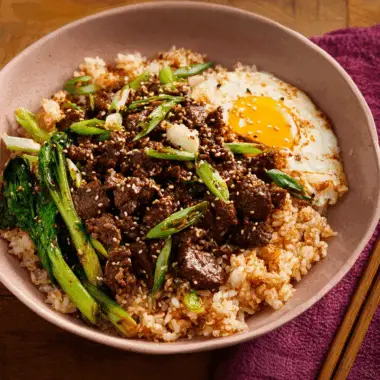The perfect hug-in-a-bowl for chilly days, this Roasted Kabocha Squash Soup is earthy, sweet, and deeply comforting. Roasting the kabocha intensifies its natural flavor, and the addition of ginger, cumin, and coriander brings warmth and complexity to every spoonful.
It’s silky without needing cream, making it a naturally dairy-free option. Whether you’re preparing for a cozy night in or looking to impress guests with a seasonal starter, this soup delivers rich taste and wholesome goodness in every bite. A splash of lime juice at the end adds a bright contrast that truly makes the flavors pop.
Full Recipe:
-
1/2 large kabocha squash (about 3 to 4 pounds)
-
2 1/2 tablespoons extra virgin olive oil, divided
-
Salt to taste
-
2 cups chopped onions
-
2 celery ribs, sliced
-
3 garlic cloves, minced
-
1 (2-inch) piece of fresh ginger, peeled and grated
-
1/2 teaspoon ground cumin
-
1 teaspoon ground coriander
-
4 cups chicken stock (or vegetable stock for vegetarian)
-
2 teaspoons kosher salt
-
1/4 teaspoon ground black pepper
-
Fresh lime juice, to serve
-
Chopped fresh cilantro (optional), for garnish
Directions:
-
Preheat oven to 400°F (200°C).
-
Cut the kabocha squash into several large pieces using a heavy knife. Scoop out the seeds and stringy pulp.
-
Place squash pieces skin-side up on a foil-lined baking sheet. Rub with 1 tablespoon of olive oil and sprinkle with salt.
-
Roast for 45–60 minutes until squash is soft and caramelized. Remove and let cool.
-
In a large pot, heat remaining 1 1/2 tablespoons olive oil over medium-high heat. Add onions and celery, reduce heat to medium, and cook for 8–10 minutes until softened.
-
Add garlic, ginger, cumin, and coriander. Cook for 2 more minutes.
-
Scoop roasted squash flesh into the pot. Add stock, kosher salt, and pepper. Bring to a simmer, then reduce heat and cook partially covered for 8–10 minutes.
-
Remove from heat and blend until smooth using an immersion blender or in batches with a standard blender.
-
Adjust salt if needed. Finish with a splash of lime juice and garnish with cilantro if desired.
Prep Time: 20 minutes | Cooking Time: 60 minutes | Total Time: 1 hour 20 minutes
Kcal: 196 kcal per serving | Servings: 4–6 servings
Introduction to Kabocha Squash Soup
When fall rolls around and the air turns crisp, few things offer more comfort than a warm bowl of homemade soup. Among the countless variations available, Roasted Kabocha Squash Soup stands out for its deep flavor, creamy texture, and simplicity. Kabocha squash, also known as Japanese pumpkin, is the star of this dish. When roasted, it brings an earthy sweetness and a velvety richness that transforms even the simplest bowl into something extraordinary.
Kabocha squash soup is more than just a seasonal favorite—it’s a celebration of flavor, nourishment, and the joys of cooking with whole foods. Often overlooked in favor of more familiar varieties like butternut or acorn squash, kabocha offers a distinct advantage: it’s denser, less watery, and boasts a naturally smooth consistency ideal for pureed soups. Combined with warm spices and aromatics, it’s a culinary hug for cool-weather days.
What Makes Kabocha Squash Unique?
Kabocha squash has a rich culinary history and has been used in Japanese cuisine for centuries. It resembles a small, squat pumpkin with dark green, mottled skin—though some varieties can appear reddish or orange. What makes it special is its texture and taste: once cooked, its flesh is incredibly smooth and dense, almost buttery, with a flavor profile somewhere between a sweet potato and pumpkin.
Unlike many other winter squash, kabocha is mostly edible flesh with relatively few seeds and minimal stringy pulp. This means you get more yield per squash and a more flavorful base for your recipes. The deep orange flesh is rich in beta-carotene, making it both visually appealing and highly nutritious.
Flavor Profile and Aromatics
One of the defining characteristics of roasted kabocha squash soup is its complex yet balanced flavor profile. Roasting the squash before blending enhances its natural sweetness and brings out caramelized notes that add depth to the soup. The soup is often flavored with aromatics like garlic, onion, and fresh ginger, which provide a savory backbone and a touch of heat.
Ground spices such as cumin and coriander elevate the dish further. These spices complement the sweetness of the squash and give the soup a warm, earthy base. A splash of fresh lime juice added before serving helps brighten the flavor and cut through the richness, while fresh herbs like cilantro offer a burst of freshness.
Notably, this soup doesn’t require cream to be creamy. The roasted squash itself provides enough body and silkiness, making it an excellent dairy-free or vegan option when made with vegetable broth.
Nutritional Benefits
Kabocha squash soup isn’t just delicious—it’s also incredibly nutrient-dense. One serving typically contains around 196 calories, with a balanced mix of carbohydrates, fiber, and healthy fats. It’s a low-calorie dish that doesn’t compromise on taste, making it a great option for those watching their intake or looking to incorporate more whole foods into their diet.
The squash is high in beta-carotene, which the body converts into vitamin A—a crucial nutrient for eye health, immune function, and skin regeneration. It’s also a good source of vitamin C, potassium, and iron. The added ginger offers anti-inflammatory benefits, while garlic is known for its immune-boosting properties.
Thanks to its high fiber content and low glycemic index, kabocha squash helps maintain steady blood sugar levels, making this soup a smart choice for anyone seeking a balanced meal.
Why Roasting Matters
Roasting is the key to unlocking the deepest flavors in kabocha squash. While it’s possible to boil or steam the squash, roasting caramelizes the natural sugars, resulting in a sweeter, nuttier flavor and a richer texture. The process also reduces moisture, which leads to a thicker, more luxurious soup.
When roasting, the squash pieces are usually placed skin-side up and brushed with a bit of olive oil. As they cook, their edges begin to brown and soften, concentrating their natural sugars. Once cooled, the skin is removed and the flesh is easily scooped out for blending.
This technique not only makes the soup more flavorful but also reduces the need for added thickeners or dairy, creating a healthier, whole-food-based dish.
Ideal for Make-Ahead Meals and Meal Prep
Roasted kabocha squash soup is a dream for meal preppers. It keeps well in the fridge for up to five days, and because it contains no cream, it also freezes exceptionally well. After allowing it to cool completely, store it in airtight containers or freezer bags, label them with the date, and freeze for up to three months.
When ready to enjoy, thaw the soup overnight in the refrigerator, then gently reheat it on the stovetop or in the microwave. Be sure to stir occasionally to prevent scorching and ensure an even temperature throughout.
This makes it an excellent candidate for busy weeknights, office lunches, or hosting guests—simply make a large batch ahead of time and reheat as needed.
Garnishing and Serving Suggestions
Though this soup is delicious on its own, thoughtful garnishes can elevate the eating experience. Fresh lime juice, added just before serving, helps cut through the richness and adds a bright, citrusy note. Chopped fresh cilantro adds color, aroma, and a burst of herbaceous flavor that complements the warming spices in the soup.
For added texture, consider topping your bowl with roasted pumpkin or kabocha seeds, a dollop of dairy-free yogurt, or a swirl of coconut milk. A slice of toasted sourdough or garlic bread on the side turns this soup into a satisfying full meal.
This soup is also highly adaptable. You can customize it with chili flakes for a spicier kick, stir in a handful of spinach for added greens, or even finish it with toasted sesame oil for an Asian-inspired variation.
Cultural and Seasonal Significance
Kabocha squash has long held significance in Japanese and Korean cuisines, where it’s enjoyed in soups, stews, and tempura. Its naturally sweet, dense flesh is celebrated for its ability to absorb flavors while retaining its form and integrity when cooked.
In Western kitchens, kabocha is increasingly popular during autumn and winter months, both for its seasonal availability and its compatibility with traditional fall spices and ingredients. It provides a refreshing alternative to more commonly used squashes and offers a slightly exotic twist on classic comfort foods.
As interest in global flavors and plant-based eating continues to rise, kabocha squash soup is gaining traction as a go-to dish for foodies and health-conscious eaters alike.
Sustainability and Minimal Waste
Another benefit of this soup is its minimal waste footprint. The seeds from the kabocha squash can be rinsed, seasoned, and roasted just like pumpkin seeds. They make a healthy, crunchy snack and reduce food waste—a small but meaningful step toward more sustainable kitchen practices.
The skin, while tough and usually removed, is technically edible and can be roasted until crisp or used to flavor stocks if desired. Cooking with kabocha encourages a “use the whole vegetable” mindset that aligns with modern, sustainable cooking trends.
Conclusion: A Bowl of Comfort with Substance
Roasted Kabocha Squash Soup is more than a seasonal treat—it’s a wholesome, nourishing dish that combines health benefits with culinary sophistication. With its naturally creamy texture, warm spices, and immune-boosting ingredients, this soup embodies the essence of fall and winter comfort food.
Its versatility, simplicity, and nutritional value make it a staple worth including in any home cook’s seasonal rotation. Whether you’re making it for a quiet dinner, freezing it for later, or impressing friends with your soup game, this kabocha creation never fails to deliver.
In a world of fast meals and processed foods, a lovingly prepared bowl of roasted kabocha squash soup reminds us that sometimes, the best dishes are the ones that bring us back to basics—real ingredients, intentional cooking, and the joy of sharing something warm with the people we care about.








